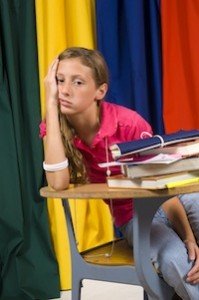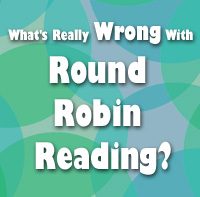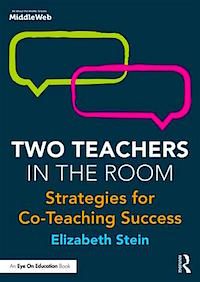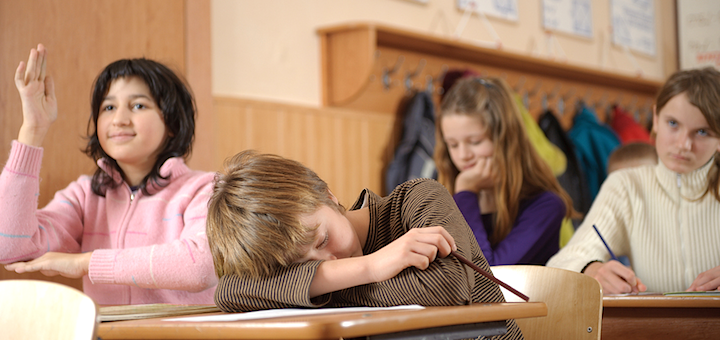A Call to Action! End a Creaky Practice Now!
A MiddleWeb Blog
 Here’s my long overdue shout out to change a creaky teaching practice. This post will get very specific, but let’s begin with some background.
Here’s my long overdue shout out to change a creaky teaching practice. This post will get very specific, but let’s begin with some background.
Come with me for the next few minutes into this not untypical classroom. I must warn you, though. You may feel uncomfortable. In fact, I honestly hope so.
From this place of discomfort each of us has two choices. First, one may feel awkward (or even enraged!) but choose to stay quiet—for whatever reason. The second choice is to re-channel that discomfort into constructive action steps toward transforming the situation.
Can you guess my choice? Yes! The second—taking actionable steps in some way—is the only choice as far as I’m concerned. Read on…feel on…and I hope you will agree.
This simulated scenario represents any class—any grade—anywhere—where the teacher(s) continue to hold onto strategies that place many students at the mercy of inadequate instructional decisions. Two disclaimers:
1. It is understood that teachers’ intentions are not the problem – they come from a place that believes their instructional decisions are in the best interest of their students.
2. This is a fictitious scenario that reflects (in part or whole) what goes on in far too many classrooms.
OK, enough introduction…let’s go. The class is waiting for our arrival. The students are secretly pleading for someone to help.
A History classroom…somewhere in America
“OK, class—take out your social studies text and turn to page 42.”
As Ms. D. adjusts the document camera to display the textbook page, Mr. C. walks around the room checking that each student is on the right page and ready for the lesson. Ms. D opens and shares a quick video to activate background knowledge. Students sit comfortably at their desks that are placed in a circle around the perimeter of the room.

“Who would like to read next?” Mr. C. calls on a student who volunteers. Following the reading, Ms. D. reviews key ideas and then asks the student who just read to call on someone to read next (a.k.a. popcorn reading).
Some students sit up with smiles—but most slouch down in their seats. A few students giggle. One student gets up to go to the bathroom. The next student reads. Mr. C. and Ms. D. walk around the room to support students’ attention to the text. The process of calling on the next readers continues for two more paragraphs.
Then the process comes to a screeching halt as the next student is called upon. This student does not know the place in the text. Ms. D. reacts to this by saying, “Come on, everyone, we know when one person is reading, the rest of us must follow along.” Silence enters the class as the class waits for the student to find his place. Mr. C. walks over to the student and shows him where to begin reading.
The student begins to read aloud—reluctantly, laboriously, disfluently. The silence in the classroom becomes louder. Every few words, one of the teachers restates the word just attempted. Finally, this student’s time is up—and Ms. D. says, “OK, let’s see who will finish us off with the last section.” She walks over to her desk, picks up a colorful jar of popsicle sticks—pulls one out—and calls out the name of the next reader. The silence in the room is booming by now.
Can you feel it? Hearts pound as every student is forced to stay at the ability and pace of the reader. Peers judge peers. Teachers control the way learners perceive themselves as learners. Teachers manage the way every student experiences the content, every moment.
I ask you: in the scenario above—how many students do you think will leave the lesson with an energizing feeling of learning and a richer understanding of the very interesting social studies content being explored?
And how many students will leave with another unrecorded encounter with the daily indignities of a time-wasting, ineffective classroom practice?
Beyond classroom management
I venture to say that even the students with strong reading and content area skills have had their learning potential compromised by the weak instruction going on in this classroom. How can teachers feel that this process is helpful and motivating to anyone? Teachers must see and feel what’s going on with students beyond their own desire to manage behavior. Let’s just stop kidding ourselves that practices like these support fluency, comprehension, and students’ motivation to learn in any useful way whatsoever.
I invite you to connect with my fictitious scenario in some way. Perhaps you will see some connections to your classroom—or the classroom of a colleague. That’s where the real discomfort comes in…and that is the place where better choices may be made.
Close the door, finally, on Round Robin Reading
Although there are many places in this simulated scenario that just scream injustice when it comes to providing meaningful learning for all learners, let’s focus on one. I mean come on! We said Good-bye to Round Robin Reading decades ago! So why is it still happening? I cringe in confusion here.
Research shows the adverse effects to this very inequitable method of “teaching.” So…why…why….why…is…it…still…happening? Peruse the research as you have time. For now, you may read this quick, powerful piece from the International Reading Association about What’s Really Wrong with Round Robin Reading, for you to become motivated to DO something to make sure this practice is not happening in your class and in your school.

– Dr. Melanie R. Kuhn (Literacy Daily, 2014)
If you are guilty of implementing any version of round robin reading—be kind to yourself—you meant no harm. We all need reminders to raise our awareness and to use that awareness to make effective changes in practice.
Fresh options
So, here is your reminder. Please. You have this opportunity to immediately replace any version of round robin reading with effective ways to nurture and nudge the readers forward in your room. It IS that easy. Just stop it. Now. And replace it with other strategies that meaningfully co-create a community of learners where every student is valued, supported, and given the opportunity to personally progress as a reader—and in general as a learner.
At Edutopia, Todd Finley shares this jumpstart on replacement strategies (including the video above) for transforming the learning in your room.
And if you know of a colleague who is still using these antiquated, inequitable classroom reading practices—you MUST speak up. Break the silence of acceptance. Be on the lookout and share research with colleagues so you become part of the effort to move every classroom in your school toward effective and just instructional practices—for every learner in each room.
Are you with me? Do you see and feel the ease of immediately replacing ineffective practice with valued and dignified practices? Our students need us to be ready NOW.
_______________________________________________
Elizabeth 




































Thank you Elizabeth!!! It is so important to address this practice that I still see so much of! You continue to be a brave beacon of justice and outstanding instruction for kids!